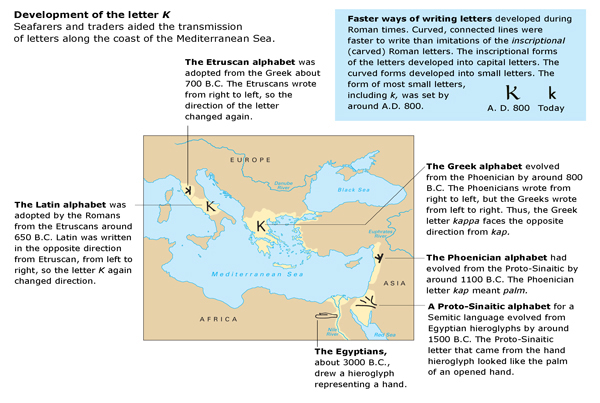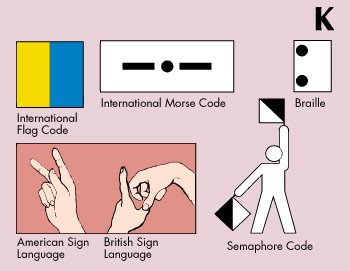K is the 11th letter of the alphabet used for the modern English language. It is also used in a number of other languages, particularly German.

The English letter K is found in such words as king and kitchen. When the letter K ought to be doubled, based upon the rules of English spelling, it is usually instead spelled CK, as in buckle. At the beginning of a word, K is silent before N, as in knock and know.
Scholars believe the letter K evolved from an Egyptian hieroglyph (pictorial symbol) that represented the palm of an open hand. Hieroglyphs were adapted to be used for a Semitic language by around 1500 B.C. The alphabet for this Semitic language—the earliest known alphabet— is called Proto-Sinaitic. By 1100 B.C., an alphabet for another Semitic language, Phoenician, had evolved from Proto-Sinaitic. See Semitic languages .
The Phoenician letter that can be traced to the Egyptian open-hand hieroglyph is the 11th letter of the Phoenician alphabet, kap. The Phoenicians used the letter to represent the beginning K sound of kap. Around 800 B.C., when the Greeks adapted the Phoenician alphabet, they changed kap to kappa and continued using it for the K sound. When the Etruscans borrowed the alphabet from the ancient Greeks about 700 B.C., however, they used three letters—gamma, kappa, and qoppa—for the K sound before different vowels.
After the Romans adopted the Etruscan alphabet by around 650 B.C., they made little use of K. Latin used the letter C to represent this sound. In fact, even today the letter K is rarely used in the Romance languages that developed from Latin, such as Spanish, French, and Italian. The letter K was revived for the Germanic languages, which include German and English. Words in German using K include kalt (cold) and klein (small).

